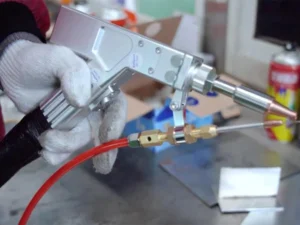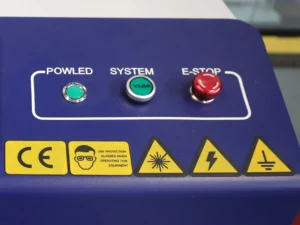Introduction:
In the previous article, we discussed the principles and characteristics of Deep Penetration Laser Welding. Here, we will focus on the main process parameters. This is helpful for you to know more about this welding technique.
The Main Process Parameters Of Deep Penetration Laser Welding

1. Laser power
There is a threshold value of laser energy density in laser welding. Below this value, the penetration depth is very shallow. Once this value is reached or exceeded, the penetration depth will be greatly increased. Only when the laser power density on the workpiece exceeds a threshold value (depending on the material) will the plasma be generated. This marks the progress of stable deep penetration welding.
If the laser power is below this threshold, only surface melting of the workpiece occurs. That is stable heat conduction welding. However, when the laser power density is near the critical condition for the formation of small holes, deep penetration welding and conduction welding are performed alternately. This becomes an unstable welding process, resulting in large fluctuations in penetration depth.
During laser deep penetration welding, the laser power controls the penetration depth and welding speed at the same time. Welding penetration is directly related to beam power density and is a function of incident beam power and beam focal spot. In general, for a laser beam of a certain diameter, the depth of penetration increases as the beam power increases.
2. Beam focal spot
Beam spot size is one of the most important variables in laser welding. Because it determines power density. But for high-power lasers, its measurement is difficult. Although there are many indirect measurement techniques.
The diffraction-limited spot size of the beam focus can be calculated according to the light diffraction theory. But due to the existence of focusing lens aberration, the actual spot size is larger than the calculated value. The simplest practical method is the isothermal profiling method. That is to measure the focal spot and perforation diameter after charring and penetrating a polypropylene plate with thick paper. This method needs to master the laser power and the time of beam action through measurement practice.
3. Material absorption value
The absorption of laser light by a material depends on some important properties of the material. Such as absorptivity, reflectivity, thermal conductivity, melting temperature, evaporation temperature, etc.
The most important thing is the absorption rate.
The factors that affect the absorption rate of the material to the laser beam include two aspects:
- First, measure the absorbance of the polished surface of the material. It was found that the resistivity of the material is proportional to the square root of the resistivity coefficient. The resistivity coefficient changes with temperature.
- Second, the surface condition (or finish) of the material has a more important effect on the beam absorption rate. Therefore it has a significant effect on the welding effect.
Non-metals such as ceramics, glass, rubber, and plastics have a high absorption rate at room temperature. However, metallic materials have a poor absorption rate at room temperature. And once the material melts or even evaporates, it will increase sharply. Using a surface coating or surface oxide film effectively improves the material’s light beam absorption.
4. Welding speed
The welding speed has a great influence on the penetration depth. Increasing the speed will make the penetration shallower. But if the speed is too low, the material will be over-melted, and the workpiece will be welded through. Therefore, a suitable welding speed range for a specific material with a certain laser power and thickness exists. The maximum penetration depth can be obtained at the corresponding speed value.

5. Protective gas
Inert gas is often used to protect the molten pool during laser welding. Some materials are welded regardless of surface oxidation, and the protection may not be considered. But for most applications, helium, argon, nitrogen, and other gases are often used as protection.
-
Helium
Helium is not easily ionized (higher ionization energy). This allows the laser to pass through smoothly, and the beam energy reaches the surface of the workpiece without hindrance. This is the most effective shielding gas used in laser welding. But it is more expensive.
-
Argon gas
Argon gas is cheaper and denser, so the protection effect is better. However, it is susceptible to high-temperature metal plasma ionization. This can shield part of the beam from hitting the workpiece, reduce the effective laser power for welding, and damage the welding speed and penetration. The weldment surface protected by argon is smoother than that when protected by helium.

-
Nitrogen
Nitrogen is the cheapest shielding gas. However, it is unsuitable for welding some types of stainless steel, mainly due to metallurgical problems, such as absorption. Sometimes, this produces porosity in the overlapping area.
The use of protective gas is beneficial, mainly in the following three aspects:
- Protect the workpiece from oxidation during soldering.
- Protect the focusing lens from metal vapor contamination and sputtering of liquid droplets, especially in high-power laser welding. Because the ejection becomes powerful, it is necessary to protect the lens now.
- Dissipate the plasma shield produced by high-power laser welding. The metal vapor absorbs the laser beam and ionizes into a plasma cloud. The protective gas around the metal vapor is also ionized due to heat. If too much plasma is present, the laser beam is somewhat consumed by the plasma. Plasma exists on the working surface as a second energy, which makes the penetration shallow and the surface of the weld pool widen. The recombination rate of electrons is increased by increasing the three-body collisions of electrons with ions and neutral atoms to reduce the electron density in the plasma. The lighter the neutral atoms, the higher the collision frequency and recombination rate. On the other hand, only the protective gas with high ionization energy will not increase the electron density due to the ionization of the gas itself.
6. Lens focal length
The focusing method is usually used to condense the laser during welding, and a lens with a focal length of 63~254mm is generally used. The focus spot size is proportional to the focal length. The shorter the focal length, the smaller the spot. However, the focal length also affects the focal depth. That is, the focal depth increases synchronously with the focal length. So, a short focal length can increase the power density. Because of the small focal depth, the distance between the lens and the workpiece must be precisely maintained, and the penetration depth is not large.
Due to the influence of spatter and laser mode generated in the welding process, the shortest focal depth used in actual welding is mostly the focal length of 126mm (5″). When the joint is large or the weld seam needs to be increased by increasing the spot size, you can choose a lens with a focal length of 254mm. In this case, a higher laser output power (power density) is required to achieve the deep penetration pinhole effect.
When the laser power exceeds 2kW(especially for the 10.6μm CO2 laser beam), due to the use of special optical materials to form the optical system, the reflective focusing method is often used to avoid the risk of optical damage to the focusing lens. A polished copper mirror is generally used as the reflector. It is often recommended for focusing high-power laser beams due to effective cooling.
7. Focus position
The focal point position is critical to maintaining adequate power density when welding. Changes in the position of the focal point relative to the workpiece surface directly affect the weld width and depth.
In most laser welding applications, the focal spot is typically located about 1/4 of the desired fusion depth below the workpiece surface.
8. Laser beam position
When laser welding dissimilar materials, the laser beam position controls the final quality of the weld, especially in the case of butt joints than lap joints. For example, when a hardened steel gear is welded to a mild steel drum, proper control of the laser beam position will help produce a weld with a relatively cracking-resistant and predominantly low-carbon component. In some applications, the geometry of the workpiece to be welded requires the laser beam to be deflected by an angle. When the deflection angle between the beam axis and the joint plane is within 100 degrees, the absorption of laser energy by the workpiece will not be affected.
9. Gradual rise and fall control of the laser power at the start and end points of welding
During laser deep penetration welding, small holes always exist regardless of the depth of the weld. When the welding process is terminated, and the power switch is turned off, a pit will appear at the end of the weld. In addition, when the laser welding layer covers the original weld seam, excessive absorption of the laser beam will occur. This results in overheating of the weldment or generation of pores.
To prevent the above phenomena from happening, the power start and stop points can be programmed to adjust the power start and end times. The initial power is electronically increased from zero to the set power value in a short period. And the welding time can be adjusted. Finally, the power is gradually reduced from the set power to zero when the welding is terminated.
